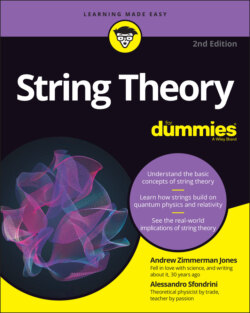Читать книгу String Theory For Dummies - Andrew Zimmerman Jones - Страница 55
Explaining quantum field theory using string theory
ОглавлениеOne of the major successes of string theory is something called the Maldacena conjecture, or the AdS/CFT correspondence. (We get into what this means in Chapter 13.) Developed in 1997 and later expanded, this correspondence appears to give insights into gauge theories, like those at the heart of quantum field theory, and their relation to gravity. (See Chapter 2 for an explanation of gauge theories.)
The original AdS/CFT correspondence, written by Juan Maldacena, argues that strings (that is, quantum gravity) in certain D-dimensional universes are equivalent to certain quantum field theories (without gravity) in a (D-1)-dimensional universe. This sounds confusing (it is), but in a nutshell, it means that quantum gravity is a bit like the Standard model (but for a universe in one dimension less), and the Standard model is a bit like quantum gravity (but for a universe in one dimension more). This is a very surprising way to think about quantum gravity (first anticipated by Nobel laureate Gerard ’t Hooft), which finds its most precise realization in Maldacena’s AdS/CFT correspondence.
More precisely, Maldacena proposed that a certain 3-dimensional (three space dimensions, like our universe) gauge theory, with the most supersymmetry allowed, describes the same physics as a string theory in a 4-dimensional (four space dimensions) world. This means that questions about string theory can be asked in the language of gauge theory, which is a quantum theory that physicists know how to work with!
